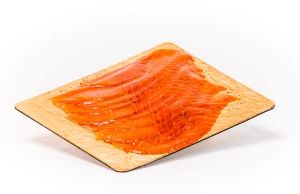
While there may be just one word to describe the fish category 'smoked', there are a ton of adjectives that have been added to this basic description as new and wonderful ways to smoke fish have been invented. "Hot smoked", "cold smoked", "candy smoked", "jerky", "pepper smoked" - just to name a few.
A long time ago, lost in the mist of time, indigenous peoples the world over discovered that if you leave thin strips of fish in the smoke of a fire (but not so close to cook it), the fish gains a shelf life. A large miracle for humans living a subsistence lifestyle.
For many thousands of years our early ancestors have been “smoking” meat, and although we’re not entirely sure how we stumbled upon this process, we do know that in the early years it was as a means to avoid spoilage and preserve meat rather than just create great flavours. Communities that lived on the coasts in the Stone Age were surrounded by a never-ending source of fish, but many also had months where hunting was less fruitful, and so they needed to create a way of preserving their catches.
 The smoking process discovered by our ancestors many moons ago slowly cooks the fish, dehydrates it and deters the growth of bacteria. This process and method has been passed down to us and improved along the way. We know that in Medieval Europe many communities had smoke houses where fish in coastal communities were smoked and stored for preservation. Poorer communities would hang their meat high up in fireplaces after placing ash over the flames to create a smoky environment.
The smoking process discovered by our ancestors many moons ago slowly cooks the fish, dehydrates it and deters the growth of bacteria. This process and method has been passed down to us and improved along the way. We know that in Medieval Europe many communities had smoke houses where fish in coastal communities were smoked and stored for preservation. Poorer communities would hang their meat high up in fireplaces after placing ash over the flames to create a smoky environment.
Although we know that this process has been used for thousands of years, the first commercial use likely dates back to the seventeenth century in Poland, but today, due, to it’s popularity, smoking is carried out across the world and is used for a variety of meats and fish, mostly kippers (smoked herring), smoked salmon, smoked trout and smoked haddock. Today of course, we are smoking fish to add that recognisable flavour rather than for the sake of preserving it.
The Difference Between Hot-Smoked and Cold-Smoked Salmon?
There is nothing better this time of year than smoked salmon for the holidays. It has a rich flavor and bright color. It is also a healthy option that is full of flavor. When you are choosing smoked salmon, you have two options: hot-smoked salmon or cold-smoked salmon. These two types of smoked salmon have different textures, tastes and uses.
Cold-smoked salmon has a silky texture and just a hint of a smoky flavor. It is only lightly seasoned so that the bright taste of the salmon shines through. It goes over well on a bagel with cream cheese and capers. It is also perfect for bite-sized hors d'oeuvres or a charcuterie board with gourmet crackers and cheese.
Hot-smoked salmon has a flaky texture and deeper smoky flavor. After it is cured, it is often coated with a glaze or rub before it is smoked. Black pepper, teriyaki and maple are common flavors of hot-smoked salmon. This smoked salmon tastes great in creamy dips, tarts, soups and quiches. It is also a popular choice for omelets and scrambles.
The reason why cold-smoked salmon and hot-smoked salmon have such different tastes and textures is because of their different curing and smoking processes. The curing process is different for cold-smoked salmon versus hot-smoked salmon. Cold-smoked salmon is dry-cured in salt to draw out a lot of moisture. Hot-smoked salmon is cured in salty water or wet brine before being smoked.
 After the salmon has been cured, usually overnight, it is smoked. Cold-smoked salmon is smoked at a very low temperature of roughly 90 degrees Fahrenheit. Hot-smoked salmon is smoked at a higher temperature around 120 degrees Fahrenheit.
After the salmon has been cured, usually overnight, it is smoked. Cold-smoked salmon is smoked at a very low temperature of roughly 90 degrees Fahrenheit. Hot-smoked salmon is smoked at a higher temperature around 120 degrees Fahrenheit.
The low temperature that cold-smoked salmon in smoked at allows it to have a silk-smooth texture, fresh taste and bright color that is similar to raw salmon. The higher temperature that hot-smoked salmon is smoked at is what gives it a flaky texture and smokier flavor.
Both types of smoked salmon can be eaten cold right out of the package. Hot-smoked salmon can also be reheated and is great in hot dishes. Unlike fresh salmon, which should be prepared and eaten within 48 hours, smoked salmon has a longer shelf life. It can be enjoyed for up to a week.
If you want smoked salmon for the holidays, gifts, or to enjoy yourself, stop by Oak Bay Seafood! See you at the shop.

